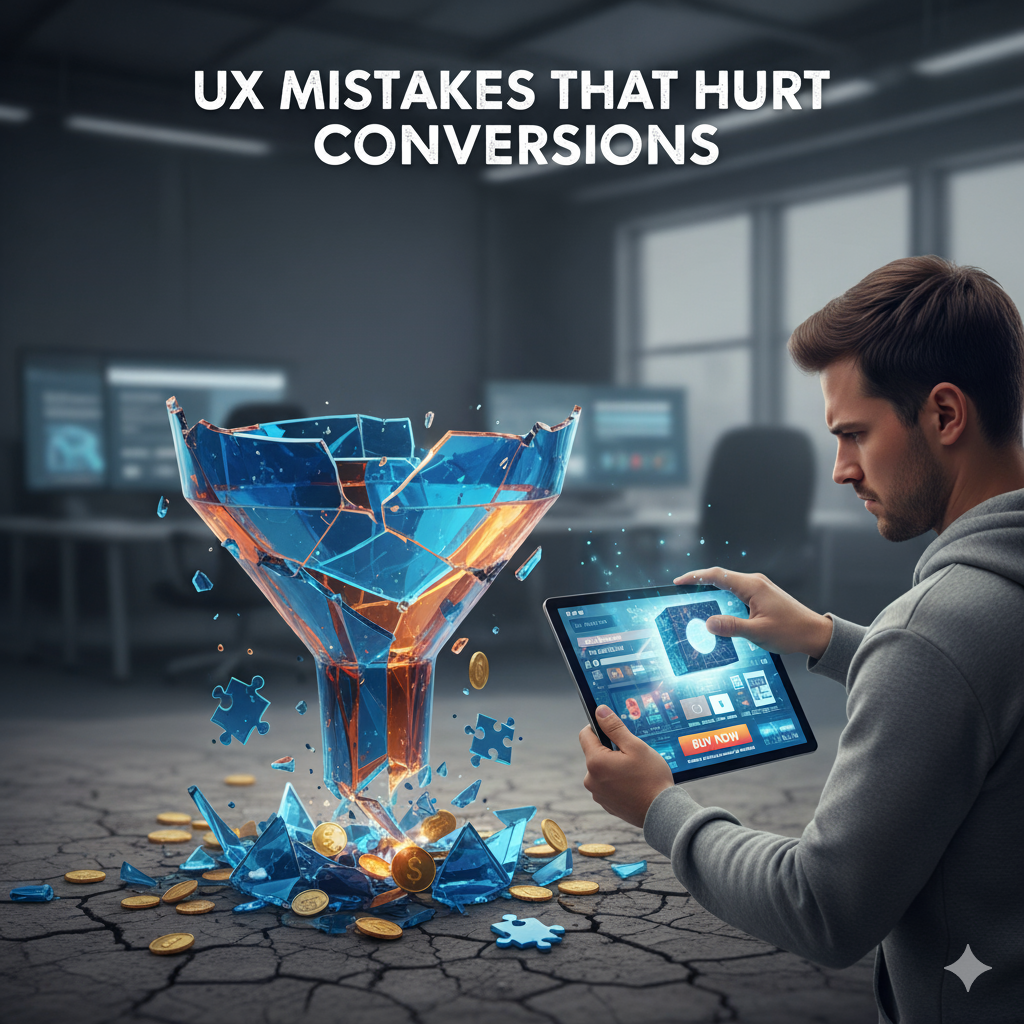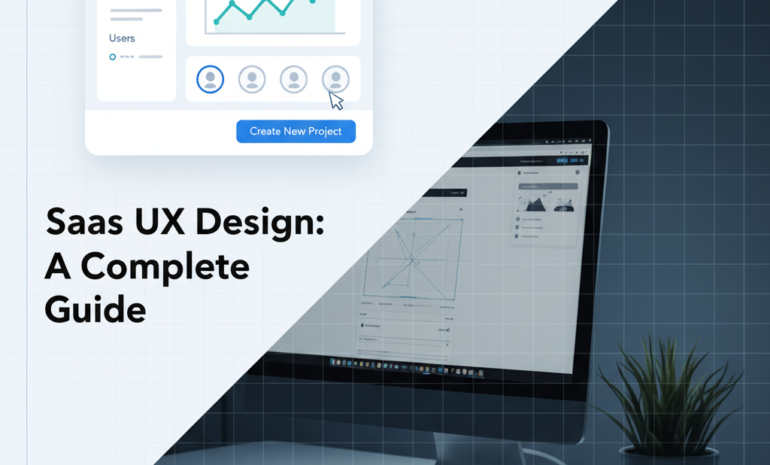Every click, scroll, or hesitation on your website says something about your user experience. When users struggle to find information, lose patience, or fail to trust your layout, they don’t convert; they leave.
Businesses often blame ads or pricing for poor results, but most of the time, it’s the site experience quietly killing conversions.
Let’s break down the real UX mistakes that push your visitors away and how you can fix them before more sales slip through your fingers.
1. Slow Loading Speed
Nothing kills a potential sale faster than waiting. If your website takes longer than three seconds to load, half of your audience is already gone. A slow site feels unprofessional and creates doubt before your message even loads.
Why It Hurts Conversions
Users associate speed with reliability. A fast site feels secure and trustworthy, while a slow one feels outdated and risky to transact with.
How to Fix It
- Compress large images and remove unnecessary animations.
- Use caching tools or a content delivery network (CDN).
- Test your site speed on both desktop and mobile using Google PageSpeed Insights.
Speed is not a technical luxury anymore; it’s the difference between “add to cart” and “exit tab.”

2. Confusing Navigation
When users land on your website, they’re not exploring, they’re hunting. If your menu layout forces them to think twice, you’ve already lost them.
Why It Hurts Conversions
Confusing navigation makes users feel lost. A lost visitor doesn’t trust the site enough to share payment details.
How to Fix It
- Keep main navigation visible and clear.
- Use predictable labels like “Services,” “Pricing,” “Contact.”
- Avoid dropdowns that hide your key pages.
If users can’t reach what they need in three clicks or less, your navigation isn’t working.
3. Weak Call-to-Actions (CTAs)
Most websites fail because they whisper instead of instruct. “Learn more” or “Click here” doesn’t drive action, it causes hesitation.
Why It Hurts Conversions
A vague CTA leaves users wondering what happens next. They hesitate, and hesitation kills momentum.
How to Fix It
- Use action-driven CTAs like “Get Your Free Quote,” “Start My Trial,” or “Book a Demo.”
- Make CTAs visually stand out with contrast and size.
- Place them strategically, after value statements, not before.
A clear CTA gives direction and confidence. You’re not pushing; you’re guiding.
4. Overloaded Homepage
Many businesses try to fit everything on one screen, with all services, offers, awards, and testimonials crammed together. It looks impressive to you but overwhelming to visitors.
Why It Hurts Conversions
Cognitive overload makes users tune out. When they can’t quickly understand what you offer, they leave instead of exploring.
How to Fix It
- Focus your homepage on a single primary goal (like lead generation or sale).
- Use short, focused sections with visual breathing room.
- Show one key message above the fold that explains what your business does and who it helps.
Your homepage isn’t your portfolio, it’s your handshake.
5. Ignoring Mobile Experience
Over 70% of users in the UAE browse on mobile devices. Yet many businesses still design for desktop and hope it “adjusts.” That’s a mistake costing conversions daily.
Why It Hurts Conversions
A poor mobile layout frustrates users, zooming, side-scrolling, or hitting wrong buttons. When payment or form fields misalign, users quit halfway.
How to Fix It
- Design mobile-first, not mobile-adapted.
- Keep buttons large enough for thumbs.
- Test checkout flow on different devices.
Your design should feel made for the hand, not just shrunk from a desktop screen.
6. Weak Trust Signals
You may have the best offer, but without visible trust indicators, users won’t risk entering card details.
Why It Hurts Conversions
Online trust is visual. No SSL, no reviews, no contact details, no conversion.
How to Fix It
- Display security badges and SSL certificates.
- Add real testimonials with names or company logos.
- Show contact info or a business address in the footer.
Trust is not built through words like “secure” or “reliable.” It’s built through what users see and feel.
7. Complicated Checkout Process
Many eCommerce businesses lose customers at the final step. They work hard to drive traffic, but forget to make buying easy.
Why It Hurts Conversions
Every extra field, unnecessary login, or unclear step adds friction. Users feel it instantly.
How to Fix It
- Allow guest checkout.
- Remove optional fields; keep only essentials.
- Show progress indicators so users know how many steps remain.
The smoother your checkout, the higher your completion rate.
8. Poor Content Hierarchy
If everything looks equally important, nothing feels important. A bad hierarchy confuses the eye and the mind.
Why It Hurts Conversions
Users don’t read websites; they scan. Without a clear flow, their attention jumps and disappears.
How to Fix It
- Use headings, subheadings, and whitespace strategically.
- Highlight key numbers, benefits, or keywords.
- Guide the eye from top to bottom naturally.
A good hierarchy is invisible. It makes users feel the site “just works” without knowing why.
9. Ignoring User Feedback
Businesses often rely on guesswork instead of actual behaviour. Ignoring user feedback means repeating the same mistakes longer than you should.
Why It Hurts Conversions
UX problems that frustrate one user will frustrate hundreds more. Each lost conversion adds up silently.
How to Fix It
- Use tools like Hotjar or Microsoft Clarity to see heatmaps and recordings.
- Conduct surveys asking what frustrated them or what they expected to find faster.
- Test small design changes instead of redesigning everything blindly.
Listening to your audience is cheaper than losing them.
10. Unclear Value Proposition
When visitors arrive, they ask one silent question: “Why should I choose you?” If your website doesn’t answer that within seconds, the back button wins.
Why It Hurts Conversions
A weak value proposition makes users feel like you’re just another option, not the best one.
How to Fix It
- State what you offer and how it helps clearly above the fold.
- Focus on user benefit, not features.
- Avoid industry jargon or buzzwords.
Your site’s first impression must tell visitors, “You’re in the right place.”
11. Too Many Pop-ups
Pop-ups can capture leads when used wisely. But when every action triggers one, they interrupt instead of convert.
Why It Hurts Conversions
Pop-ups that cover content or appear instantly make users close the tab. They feel trapped instead of engaged.
How to Fix It
- Use exit-intent or time-based pop-ups.
- Offer something valuable, not just “Subscribe now.”
- Limit one pop-up per session.
Respect your visitor’s attention. If they feel forced, they won’t return.
12. Cluttered Forms
Long, detailed forms feel like a chore. Even interested users hesitate to fill too many boxes.
Why It Hurts Conversions
Complex forms increase drop-offs. Each unnecessary question feels like extra effort without clear benefit.
How to Fix It
- Ask for the minimum information first (name, email, phone).
- Use multi-step forms for longer data collection.
- Make sure every field has a reason.
If your form feels like homework, your conversions will show it.
13. Ignoring Visual Consistency
Colour mismatches, random fonts, and uneven spacing make your website look unreliable. It’s not about art, it’s about trust.
Why It Hurts Conversions
Inconsistent visuals signal carelessness. Users subconsciously feel the same carelessness could apply to your product or service.
How to Fix It
- Stick to a defined colour palette and font family.
- Keep consistent spacing, buttons, and image styles.
- Follow a grid system for balance.
A consistent design tells users your brand is stable and professional.
14. No Clear Next Step
Some pages educate well but fail to direct users. After reading your service or product details, visitors should know exactly what to do next.
Why It Hurts Conversions
A lack of direction leaves visitors hanging. Even interested users won’t hunt for your contact button.
How to Fix It
- End each page with a strong CTA related to the content.
- Use small prompts like “Ready to get started?” or “Schedule your consultation.”
- Avoid dead ends, every page should lead somewhere.
Your content should feel like a guided tour, not a maze.
15. Neglecting Micro-Interactions
Small details like button animations, hover effects, or confirmation messages often go unnoticed, but they add huge value.
Why It Hurts Conversions
When users click without feedback, they think something’s broken. Micro-interactions reassure them that the action worked.
How to Fix It
- Add subtle button hover effects.
- Use visual confirmation for form submissions or cart additions.
- Keep transitions quick and smooth.
These moments don’t just look good; they make users trust the system.
16. Ignoring Accessibility
Accessibility is not just about compliance; it’s about usability for everyone. When your design ignores accessibility, you shut out potential customers.
Why It Hurts Conversions
If users with vision or mobility challenges can’t interact easily, they’ll abandon the process entirely.
How to Fix It
- Use proper contrast between text and background.
- Add alt text for images.
- Ensure forms and buttons are keyboard-friendly.
Accessible design means everyone can become your customer.
17. Overuse of Stock Images
Stock photos make your site feel generic. Users recognise them instantly, and once they do, they assume your brand lacks authenticity.
Why It Hurts Conversions
If your visuals look staged, users won’t feel emotionally connected.
How to Fix It
- Use original images wherever possible.
- If using stock photos, choose real, candid-looking ones.
- Mix photos with simple custom illustrations for personality.
Authenticity converts. Polished fakery doesn’t.
18. Ignoring Emotional Design
UX is not just functionality; it’s psychology. Many businesses design around what users should do, not what they feel while doing it.
Why It Hurts Conversions
When a user doesn’t emotionally connect, your offer feels mechanical. People buy feelings, not just products.
How to Fix It
- Use relatable visuals, testimonials, and tone.
- Add subtle emotional triggers like empathy or aspiration.
- Focus copy on outcomes, not just features.
If your website doesn’t move them, it won’t move sales either.
19. Poor Product Presentation
For eCommerce, the way products appear defines perception. Low-quality images, inconsistent lighting, or missing details make your product seem cheap even if it’s not.
Why It Hurts Conversions
Online, visuals are the product. Users can’t touch, feel, or test; they judge based on what they see.
How to Fix It
- Use high-resolution images with zoom and 360-view options.
- Add lifestyle photos showing real usage.
- Include short demo videos if possible.
Every image should make buyers imagine the product in their hands.
20. Not Testing or Iterating
Even the best-looking website can underperform if it’s never tested. UX isn’t a one-time project; it’s ongoing research.
Why It Hurts Conversions
Assumptions age quickly. What worked last year might fail today.
How to Fix It
- Run A/B tests for layout, CTAs, and headlines.
- Track heatmaps and conversion funnels monthly.
- Keep evolving your site based on behaviour, not guesswork.
Continuous testing keeps you aligned with real user intent.
How Brandout Helps
If your website traffic looks fine but conversions stay low, poor UX could be the reason. At Brandout, we create practical, result-driven UX and UI designs for every CMS.
Our approach focuses on what your audience actually does, not what looks good on a screen. Whether it’s your landing page, eCommerce store, or SaaS dashboard, we help you turn visitors into loyal customers with experiences built to convert.
Wrapping Up
Good UX doesn’t mean fancy design; it means invisible design. It quietly guides visitors, builds trust, and makes buying effortless. Every misstep, from slow loading to unclear direction, creates small cracks that leak conversions.
When you fix UX issues, conversions don’t just improve; marketing spend performs better, customer trust rises, and retention grows naturally.




